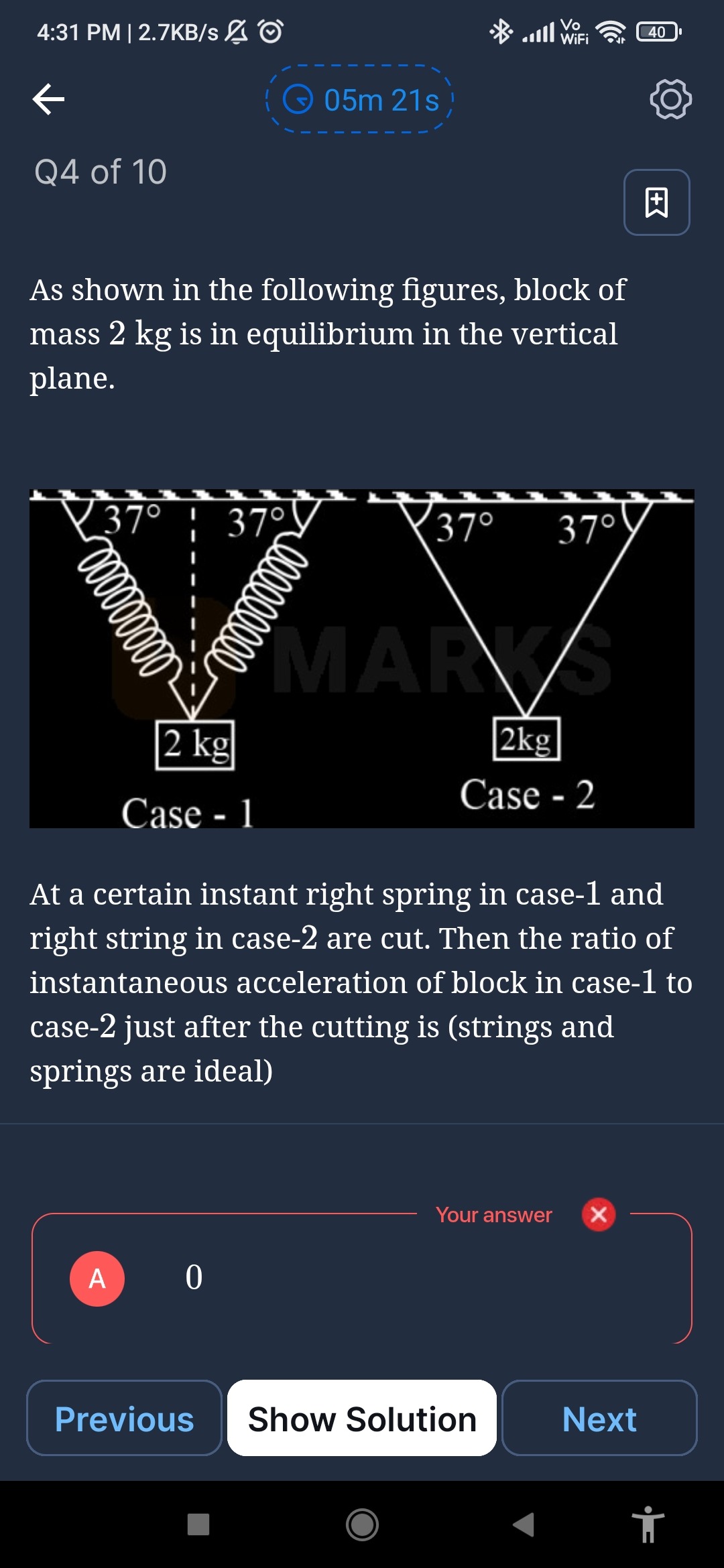Question
Question: As shown in the following figures, block of mass 2 kg is in equilibrium in the vertical plane. At...
As shown in the following figures, block of mass 2 kg is in equilibrium in the vertical plane.
At a certain instant right spring in case-1 and right string in case-2 are cut. Then the ratio of instantaneous acceleration of block in case-1 to case-2 just after the cutting is (strings and springs are ideal)

0
1
Solution
Let m be the mass of the block and θ=37∘ be the angle the springs/strings make with the vertical.
Case 1: Right spring is cut Initially, the block is in equilibrium. Let Fs be the force in each spring. Vertical equilibrium: 2Fscos(θ)=mg Horizontal equilibrium: Fssin(θ)−Fssin(θ)=0 (already satisfied) So, Fs=2cos(θ)mg.
Just after the right spring is cut, the forces acting on the block are:
- The force from the left spring, Fs1, which is unchanged immediately after cutting. Its magnitude is Fs.
- The weight of the block, mg, acting vertically downwards.
Let's set up a coordinate system with the y-axis vertically upwards and the x-axis horizontally. Assuming the left spring is to the left of the vertical: Fs1=−Fssin(θ)i^+Fscos(θ)j^ mg=−mgj^
The net force in Case 1 is: Fnet,1=Fs1+mg=−Fssin(θ)i^+(Fscos(θ)−mg)j^ Substitute Fscos(θ)=2mg: Fnet,1=−Fssin(θ)i^+(2mg−mg)j^=−Fssin(θ)i^−2mgj^
The instantaneous acceleration in Case 1 is: a1=mFnet,1=−mFssin(θ)i^−2gj^
Case 2: Right string is cut Initially, the block is in equilibrium. Let T be the tension in each string. Vertical equilibrium: 2Tcos(θ)=mg Horizontal equilibrium: Tsin(θ)−Tsin(θ)=0 (already satisfied) So, T=2cos(θ)mg.
Just after the right string is cut, the forces acting on the block are:
- The tension from the left string, T1, which is unchanged immediately after cutting. Its magnitude is T.
- The weight of the block, mg, acting vertically downwards.
Assuming the left string is to the left of the vertical: T1=−Tsin(θ)i^+Tcos(θ)j^ mg=−mgj^
The net force in Case 2 is: Fnet,2=T1+mg=−Tsin(θ)i^+(Tcos(θ)−mg)j^ Substitute Tcos(θ)=2mg: Fnet,2=−Tsin(θ)i^+(2mg−mg)j^=−Tsin(θ)i^−2mgj^
The instantaneous acceleration in Case 2 is: a2=mFnet,2=−mTsin(θ)i^−2gj^
Comparison of Accelerations: Since the springs and strings are ideal, and the geometry (mass, angle) is the same, the force in the left spring (Fs) and the tension in the left string (T) are equal: Fs=T=2cos(θ)mg
Substituting this into the acceleration expressions: a1=−m2cos(θ)mgsin(θ)i^−2gj^=−2gtan(θ)i^−2gj^ a2=−m2cos(θ)mgsin(θ)i^−2gj^=−2gtan(θ)i^−2gj^
Thus, a1=a2. The instantaneous accelerations in both cases are identical vectors. The ratio of the magnitudes of the instantaneous accelerations is: ∣a2∣∣a1∣=∣a1∣∣a1∣=1
Using θ=37∘, tan(37∘)≈0.75: a1=a2=−2g×0.75i^−2gj^=−0.375gi^−0.5gj^ ∣a1∣=∣a2∣=(−0.375g)2+(−0.5g)2=g0.140625+0.25=g0.390625=0.625g=85g. The ratio is 5g/85g/8=1.
The user's provided answer of 0 is incorrect. The ratio of the instantaneous accelerations is 1.
